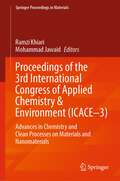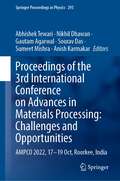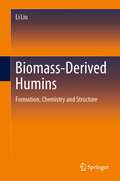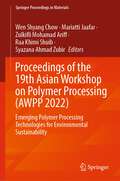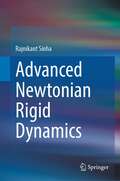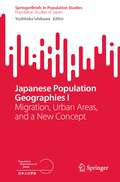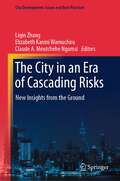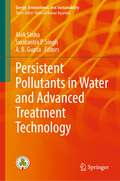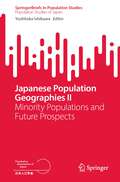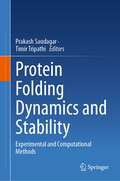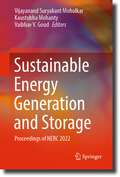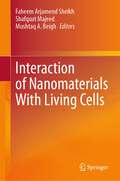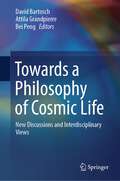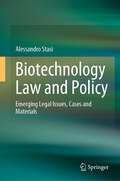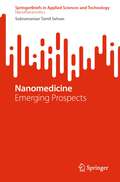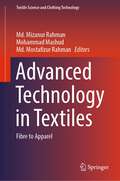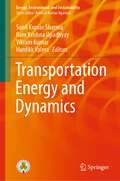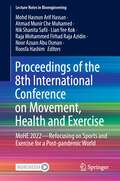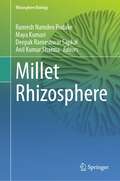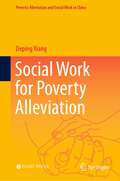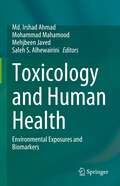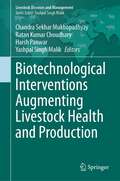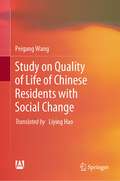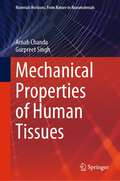- Table View
- List View
Proceedings of the 3rd International Congress of Applied Chemistry & Environment: Advances in Chemistry and Clean Processes on Materials and Nanomaterials (Springer Proceedings in Materials #23)
by Ramzi Khiari Mohammad JawaidThis book presents the selected papers presented at the Third International Congress of Applied Chemistry & Environment (ICACE–3) that took place on May 27-29, 2022. The topics of the conference covers topics from the thematic sections: (1) Environment and Climate Change; (2) Green Chemistry and Natural Substances; (3) Biobased Materials and Nanomaterials; (4) Sustainable Textiles and Clean Processes. For this edition of the conference, it is devoted to present the advantage to use annual plants and/or lignocellulose material as sources for production of fibers and/or cellulose derivatives and/or nanocellulose material with focus on their processing, properties and applications. This book benefits lecturers, students, researchers and industrialists who are working in the field of natural fiber especially in order to preserve the forest resource and to satisfy the increasing demand in pulps.
Proceedings of the 3rd International Conference on Advances in Materials Processing: AMPCO 2022, 17-19 Oct, Roorkee, India (Springer Proceedings in Physics #293)
by Abhishek Tewari Nikhil Dhawan Gautam Agarwal Sourav Das Sumeet Mishra Anish KarmakarThis book presents peer reviewed articles from the 3rd International Conference on Advances in Materials Processing: Challenges and Opportunities (AMPCO 2022), held at IIT Roorkee, India. It highlights recent progress made in the fields of materials processing, advanced steel technology and materials for sustainability. The conference is also special as it is being organized on the occasion of 60 years of the department of metallurgical and materials engineering as well as 175 years of IIT Roorkee.
Biomass-Derived Humins: Formation, Chemistry and Structure
by Li LiuThis book provides a unique perspective on atom economical utilization of biomass resources into value-added productions. Humins are inevitably formed during the process of biomass conversion, which compete with desired products, restrain the activity of catalyst and hinder the recycling of catalyst and separation of products. To further improve the efficiency of biomass conversion toward downstream products, unambiguous elucidation of the chemical structure and formation mechanism of humins are prerequisite. This book primarily presents the chemical structure analysis and formation mechanism of various biomass-derived humins, from simple molecular models to raw biomass resources. The chemical similarities and differences of various biomass-derived humins have been systematically summarized according to advanced analytical interpretation, which offers a comprehensive viewpoint for readers with chemistry, engineering and material backgrounds. Furthermore, the progress that has been achieved on humins valorization and future perspectives are discussed. Given its scope, this book can be treated as an informative resource for undergraduates, postgraduates, lecturers and researchers interested in biomass conversion from academia and industry from entry to professional levels.
Proceedings of the 19th Asian Workshop on Polymer Processing: Emerging Polymer Processing Technologies for Environmental Sustainability (Springer Proceedings in Materials #24)
by Wen Shyang Chow Mariatti Jaafar Zulkifli Mohamad Ariff Raa Khimi Shuib Syazana Ahmad ZubirThis book presents the selected papers from the 19th Asian Workshop in Polymer Processing (AWPP 2022) highlighting the latest research breakthroughs in the field of polymeric materials and processing technologies. The topics of the conference provides an exclusive forum for intellectually stimulating and engaging interactions among academicians and industrialists to share their recent scientific breakthroughs and emerging trends in polymer processing technologies and their contributions towards environmental sustainability. Its content appeals to the researchers, academics, industry practitioners working in the field of green sustainable polymers.
Advanced Newtonian Rigid Dynamics
by Rajnikant SinhaThis book discusses topics on D’Alembert’s principle, virtual work, Eulerian angles, Lagrange’s equation in generalized coordinates and motion of a top. Momental ellipsoid of a point of a rigid body and conservation principle of angular momentum are discussed in detail. This is an essential textbook on Newtonian rigid dynamics, useful for advanced undergraduate and graduate students of physics, mathematics and engineering. This book contains solutions to more than 350 examples as well as more than 350 figures, which are nicely explaining the concept of rigid dynamics. Necessary mathematics have been created at the spot where they are needed.
Japanese Population Geographies I: Migration, Urban Areas, and a New Concept (SpringerBriefs in Population Studies)
by Yoshitaka IshikawaThis is the first anthology that conveys in detail the actual situation of population geographies in Japan, a country facing some of the world's most serious demographic trends such as low fertility, population aging, and depopulation. The anthology consists of two volumes with the common title Japanese Population Geographies. All of the included entries are based on original Japanese papers written by leading geographers and published within the past few years, useful for understanding Japan’s current population geographies. The first volume analyzes the postwar transition of internal migration, examining the structural changes of population in urban areas, and proposes a new measure different from the traditional resident population. This volume also presents an investigation of the retirement migration of baby boomers as well as displacement migration due to the 2011 Great East Japan Earthquake. The second volume’s contents examine the residential choices of minority populations such as foreign residents and sexual minorities. It also discusses future prospects associated with mono-polar concentration into Tokyo, regional forecasting using population projections based on small-area units, and the importance of a politico–economic perspective in the future research. Taken as a whole, this anthology offers the following two significant contributions. First, the excellent achievements obtained in Japan, which is experiencing serious demographic trends, reflect key developments within the context of the world's population geography. The second contribution is that the book brings the latest insights and important policy implications to countries that are facing various issues associated with decreasing fertility, aging population, and declining population.
Handbook of Functionalized Nanostructured MXenes: Synthetic Strategies and Applications from Energy to Environment Sustainability (Smart Nanomaterials Technology)
by Komal Rizwan Anish Khan Abdullah Mohammed Ahmed AsiriThis book covers the various aspects of MXenes nanomaterials and its composites from the fabrication to the potential applications in energy devices, sensors, and environmental remediation. MXenes are two-dimensional (2D) transition metal carbides and nitrides which contains novel combination of properties including great conductivity and mechanical, thermal features of transition metal carbide and nitrides. In addition, MXenes nanomaterials possess high surface area, novel morphology, and layered structure and the functionalized of its surfaces gives it excellent hydrophilic characteristics and high absorption of electromagnetic radiations making them versatile materials for various applications. The beginning part of the book gives an in-depth literature covering the fundamental principles, fabrication, self-assembling strategies of nano-engineered MXenes, and their composites materials. The later chapters describe the chemical functionalization of MXenes nanomaterials for diversified applications such as electromagnetic shielding, energy storage devices (super capacitors, lithium ion batteries, CO2 capture, optical switching, transistors), photo catalysis, drug delivery, implants, tissue engineering, water purification, and sensing applications. It demonstrates that MXene-based advanced architectures promote continuous innovations and provide driving force in different fields particularly in environmental remediation and energy storage devices. This book is essential reading for all chemists, biologists, physicists, and environmental scientists working in the field of nanotechnology, energy, and environmental chemistry. It helps academics and professionals to polish their knowledge with the latest described data. It also helps professionals in developing innovative technologies by keeping in mind the applications of functionalized nanostructured MXenes.
The City in an Era of Cascading Risks: New Insights from the Ground (City Development: Issues and Best Practices)
by Liqin Zhang Elizabeth Kanini Wamuchiru Claude A. Meutchehe NgomsiThis book provides unique perspectives into newly changed political and socioeconomic urban landscapes due to COVID-19 in diverse cities and aims to provide ways to improve the resilience of cities using a global perspective, especially in a post-pandemic era. This book is divided into three sections with seventeen chapters overall. It explores the impacts of the COVID-19 on city planning, building, and maintenance; it considers city resilience and what urban risks cities are facing; and it examines urban development from diverse socioeconomic and political perspectives. The book contains multidisciplinary work by authors from China, African nations (Angola, Burundi, Cameroon, Kenya, Morocco, Nigeria), Canada, Italy, Poland, and France. This manuscript provides a global perspective as cities from Africa, China, as well as some developed countries, such as France and South Korea, were used to collect data and information concerning urban development and risks, past, present, and future responses to COVID-19 as well as any other pandemics and cities' resilience. This book is a valuable asset to urban researchers, urban city planners, urban policymakers, public officials, undergraduates, and postgraduates interested in a comprehensive comparison between diverse socioeconomic and political cities with a unique global and post-pandemic perspective in order to improve urban city resilience.
Persistent Pollutants in Water and Advanced Treatment Technology (Energy, Environment, and Sustainability)
by Alok Sinha Swatantra P. Singh A. B. GuptaThis contributed volume discusses the current status of the occurrences, fate and transport of persistent pollutants in water and wastewater. This contents compile the state-of-the-art of emerging technologies such as nanotechnology, advanced oxidation process, membrane processes, sorption, etc. for the clean-up of persistent pollutants in water including heavy metals, pharmaceuticals, phenolic compounds as well as microplastics and their by-products. This volume will be useful as a guide for the researchers to build strategies to deal with persistent pollutant. It also discusses the principal aspects of degradation mechanism of the pollutants, toxic by-products and effectiveness of the emerging technologies. This volume will be a useful guide for those working in soil and water protection, and environmental civil engineering.
Japanese Population Geographies II: Minority Populations and Future Prospects (SpringerBriefs in Population Studies)
by Yoshitaka IshikawaThis is the first anthology that conveys in detail the actual situation of population geographies in Japan, a country facing some of the world's most serious demographic trends such as low fertility, population aging, and depopulation. The anthology consists of two volumes with the common title Japanese Population Geographies. All of the included entries are based on original Japanese papers written by leading geographers and published within the past few years, useful for understanding Japan’s current population geographies. The first volume analyzes the postwar transition of internal migration, examining the structural changes of population in urban areas, and proposes a new measure different from the traditional resident population. This volume also presents an investigation of the retirement migration of baby boomers as well as displacement migration due to the 2011 Great East Japan Earthquake. The second volume’s contents examine the residential choices of minority populations such as foreign residents and sexual minorities. It also discusses future prospects associated with mono-polar concentration into Tokyo, regional forecasting using population projections based on small-area units, and the importance of a politico–economic perspective in future research. Taken as a whole, this anthology offers the following two significant contributions. First, the excellent achievements obtained in Japan, which is experiencing serious demographic trends, reflect key developments within the context of the world's population geography. The second contribution is that the publication brings the latest insights and important policy implications to countries that are facing various issues associated with decreasing fertility, aging population, and declining population.
Protein Folding Dynamics and Stability: Experimental and Computational Methods
by Prakash Saudagar Timir TripathiThis book describes recent important advancements in protein folding dynamics and stability research, as well as explaining fundamentals and examining potential methodological approaches in protein science. In vitro, in silico, and in vivo method based research of how the stability and folding of proteins help regulate the cellular dynamics and impact cell function that are crucial in explaining various physiological and pathological processes. This book offers a comprehensive coverage on various techniques and related recent developments in the experimental and computational methods of protein folding, dynamics, and stability studies. The book is also structured in such a way as to summarize the latest developments in the fiddle and key concepts to ensure that readers can understand advanced concepts as well as the fundamental big picture. And most of all, fresh insights are provided into the convergence of protein science and technology. Protein Folding Dynamics and Stability is an ideal guide to the field that will be of value for all levels of researchers and advanced graduate students with training in biochemical laboratory research.
Sustainable Energy Generation and Storage: Proceedings of NERC 2022
by Vijayanand Suryakant Moholkar Kaustubha Mohanty Vaibhav V. GoudAs India progresses fast in the 21st century, we also face daunting challenges of energy security and climate change. Tremendous development in various sectors like industry, agriculture, transport has resulted in huge rise in demand for energy. Fulfilling these demands through conventional fossil fuel based energy generation has given rise to significant emissions (both gaseous and liquids) that have caused pollution to atmosphere and aquatic eco-systems. Use of sustainable and green (or renewable) resources and technologies offers a viable and promising solutions to these issues. Last two decades have witnessed intense research activities in Indian academic institutions on renewable energy resources. These include biofuels (both liquid and gaseous) through thermochemical and biochemical conversion of biomass, solar energy through thermal and photo-voltaic routes, wind energy and hydroelectric energy. North-East Research Conclave (NERC) – 2022 was organized by Indian Institute of Technology Guwahati with aim of bringing together researchers in diverse fields of science and technology and provide a knowledge-sharing platform to achieve sustainable development goals. This monograph contains papers presented in the session on Sustainable Energy Generation and Storage in NERC. A total of 16 papers in this monograph cover wide areas in renewable energy. The contents of this monograph will of interest to students and researchers in academic institutions as well as industry.
Interaction of Nanomaterials With Living Cells
by Faheem Arjamend Sheikh Shafquat Majeed Mushtaq A. BeighThis book examines the interactions of nanomaterials with the biological system. The chapters of the book explore the natural and synthetic biomaterials that modulate immune responses for their applications in drug delivery and tissue engineering. Further, the book discusses the implications of the physiochemical properties of nanoparticles and their microenvironment on their interactions with biological systems. The chapters also present the recognitive capabilities of biomaterials for the development of novel strategies for the detection and treatment of autoimmune disorders. The book also introduces nanotechnology platforms for drug delivery and highlights current and emerging nanotechnologies that could enable novel classes of therapeutics. Towards the end, the book reviews the efficiency of drug-loaded nanoparticles in modulating the functioning of the biological milieu for improved disease treatment. Lastly, the book outlines the ethical issues regarding the use of nanoparticles for in vitro and in vivo applications. Given its scope, it is a valuable resource for graduate students and researchers interested in understanding the biomedical applications of nanoparticles and their interactions with the biological milieu.
Towards a Philosophy of Cosmic Life: New Discussions and Interdisciplinary Views
by David Bartosch Attila Grandpierre Bei PengJust as the six branches of a snow crystal converge in regular proportions toward their common center, the six contributions to this book point toward a future philosophy of cosmic life. In this sense, this edited volume represents a multidisciplinary and transcultural polylogue of distinguished authors from three continents, which aims to establish highly innovative perspectives and open new frontiers of developing philosophical reflections and scientific foundations for the emergence of a common cosmic consciousness, for an integral ecology, and for a cooperative planetary civilization of humanity. John B. Cobb, Jr. uses a process-philosophical foundation to describe life as living events expressing novelty and the cosmos as a process of self-enriching and self-evolving “Life Itself.” Chandra Wickramasinghe unfolds his scientific and philosophical perspective on cosmic life in twelve successive steps, offering a wide range of arguments and insights that support an up-to-date theory of panspermia. Attila Grandpierre presents the "Cosmic Life Principle" and the comprehensive science based upon it that is inextricably linked to the healthy and cooperative civilization, to the biological laws of nature, to the laws of logic, to the uplifting of the well-being of people and ecological communities. Chunyou Yan introduces the approach of his holographic philosophy, according to which the universe must be understood as a vast living entity, every aspect of which represents life. Bei Peng shows that the proportions of energy meridians in traditional Chinese medicine correspond to musical intervals, and on this basis she demonstrates the analogy of the human body to macrocosmic phenomena. David Bartosch offers an examination of three important systematic foundations for a poly-contextural, transcultural philosophy of cosmic life with roots in Greek, Chinese, South and West Asian, and European traditions of thought.
Biotechnology Law and Policy: Emerging Legal Issues, Cases and Materials
by Alessandro StasiThis book covers an extensive range of issues raised by biotechnological advancements from a regulatory perspective. Written in a clear and readable style, its main objective is to give readers an idea of the relationship between biotechnology and law. Biotechnology advancements and their ethical, moral, economic, and social implications in different fields and the consequential normative demands on the law are crucial to this book. The chapters cover a multitude of themes and some of the most important legal issues arising in relation to biotechnology, including the historical development of a legal framework sufficient to protect public safety, the current biotechnology regulatory system, and the rules directing the primary agencies that regulate the products of biotechnology, namely the US Food and Drug Administration, the US Department of Agriculture, and the US Environmental Protection Agency, patents and IP rights in biotechnology, the regulation of human genome editing and its impact on health research, law and emerging genome editing technologies from recombinant DNA to CRISPR/Cas9, the development of legal principles to protect property rights in the human body and allow the efficient use of human tissue, organs, DNA, and cell-lines in medical research, and legal issues arising from the use of genetic engineered plants and animals.Presenting arguments that have been drawn from careful examination of various international documents and decisions made by legal institutions and judicial bodies, this book would be a valuable read for practitioners as well as academics of biotechnology law.
Nanomedicine: Emerging Prospects (SpringerBriefs in Applied Sciences and Technology)
by Subramanian Tamil SelvanThis book highlights the emerging paradigm of nanomedicine, intersecting two burgeoning fields of nanotechnology and medicine. Numerous publications have appeared in the literature over the years, especially in cancer nanomedicine. In a boarder sense, nanomedicine aims to apply the knowledge and tools of nanotechnology in a mission to diagnose early and prevent or treat diseases using biocompatible nanoparticles (NPs). Current research in nanomedicine and its prospects depend on creating new breakthroughs at the nexus of nanomaterials and biological systems, making use of non-toxic NPs and nano/biomaterials as smart theranostic systems for a variety of diseases including cancer, neurodegenerative, orthopedic, and cardiac diseases. This book provides a review on recent advancements of nanomedicine in the aforementioned emerging areas of nanomedicine.
Advanced Technology in Textiles: Fibre to Apparel (Textile Science and Clothing Technology)
by Md. Mizanur Rahman Mohammad Mashud Md. Mostafizur RahmanThis book highlights the latest technology in textile processing along with the application of eco-friendly chemicals and reagents. As textile is the second basic human need, this industry assimilates a large share in the world economy. Nonetheless, nothing should be accomplished compromising sustainability; therefore updated technology and modern machineries are being used in the textile processing. It is not only for enhancing the efficiency but also to reduce waste and energy consumption. Moreover, Nano particles and Bio-chemicals are assumed to become integral part in the future manufacturing system. In this book, the numerical and investigation results will be presented to highlight the mentioned topics so that the application is lucidly comprehended. In a nutshell, this book is supposed to cover all the vibrant innovations in the manufacturing arena in textiles in consideration with ecological balance as well as breakthroughs in applied technology assumed to veer the general concept of maintenance of that machineries.
Transportation Energy and Dynamics (Energy, Environment, and Sustainability)
by Sunil Kumar Sharma Ram Krishna Upadhyay Vikram Kumar Hardikk ValeraThis book provides a macro-level understanding of transportation as an industry, through the lens of all the stakeholders that make up the ecosystem. It aids understanding about the transportation ecosystem, its components, challenges, contribution to economic growth, and the interplay between the stakeholders that govern the system. The contents also examine the background and history of transportation, emphasizing the fundamental role and importance the industry plays in companies, society, and the environment in which transportation service is provided. The book also provides an overview of carrier operations, management, technology, and the strategic principles for the successful management of different modes of transportation. This book is of interest to those working in academia, industry, and policy in the areas of transportation.
Proceedings of the 8th International Conference on Movement, Health and Exercise: MoHE 2022—Refocusing on Sports and Exercise for a Post-pandemic World (Lecture Notes in Bioengineering)
by Mohd Hasnun Arif Hassan Ahmad Munir Che Muhamed Nik Shanita Safii Lian Yee Kok Raja Mohammed Firhad Raja Azidin Noor Azuan Abu Osman Roosfa HashimThis book gathers papers presented at the 8th International Conference on Movement, Health and Exercise (MoHE 2022) with the conference theme "Enhancing Health and Sports Performance by Design". The topics covered include exercise science; human performance; physical activity and health; sports medicine; sports nutrition; management and sports studies; and sports engineering and technology. Its content is of interest to sports scientists, researchers and practitioners from various sports and exercise sub-disciplines.
Millet Rhizosphere (Rhizosphere Biology)
by Ramesh Namdeo Pudake Maya Kumari Deepak Rameshwar Sapkal Anil Kumar SharmaThis edited volume is the first book that explicitly explains the link between the extraordinarily small-scale microbial processes and the growth and yield attributes of millet crops. This book includes chapters emphasizing on the effects of rhizosphere biology on long-term millet crop management. Millets are a collection of small-grained cereal grasses that are grown for human carbohydrate needs. They are among the oldest crops, mainly divided into two groups: major and small millets based on seed size. Major millets are composed of sorghum (Sorghum bicolor) and pearl millet (Pennisetum glaucum); while small millets are composed of six species that includes finger millet (Eleusine coracana (L.)), little millet (Panicum sumatrense), kodo millet (Paspalum scrobiculatum (L.)), foxtail millet (Setaria italica (L.)), barnyard millet (Echinochloa frumentacea (L.)), and proso millet (Panicum miliaceum (L.). These crops are earlier considered as orphan crops, but recently due to their nutritional values it is gaining the importance. Various reports are published based on role of rhizosphere on growth and health of these crops. The rhizosphere being a dynamic interface among the plant roots and soil microbes provides a number of advantages to the millets too. The soil properties in rhizospheric region are also different as compared to the bulk soil. This book discovers the functional attributes of rhizosphere in promoting the healthy growth of millet crop and achieving higher yield during the changing climatic condition. This book is of interest to university teachers, scientists working in the millets, and policymakers in agricultural departments. Also, the book serves as additional reading material for undergraduate and graduate students of agriculture, biotechnology, microbiology, genetics, and soil science.
Social Work for Poverty Alleviation (Poverty-Alleviation and Social Work in China)
by Deping XiangThis book studies poverty issues by using social work theories and methods. It illustrates the values, theories, elements, contents, and processes of anti-poverty social work, summarizes the development of China’s anti-poverty policies, and explores the models and methods of anti-poverty social work in China. This book represents the research results of the National Social Science Foundation Project “Research on Dynamic Monitoring and Effectiveness Evaluation of the Implementation of Targeted Poverty Alleviation Strategy” (16ZDA022) and China’s Ministry of Education’s Philosophy and Social Science Development Construction (Incubation) Project Report “Anti-Poverty Development Report in China” (11JBGP038).
Toxicology and Human Health: Environmental Exposures and Biomarkers
by Md. Irshad Ahmad Mohammad Mahamood Mehjbeen Javed Saleh S. AlhewairiniThis contributed volume brings out a comprehensive collection of information on environmental toxicology, its impact on living organisms in general and human health in particular. The main focus of this book is to address human health issues and risk assessment. Toxicological studies help in understanding the impact of harmful substances including both natural and synthetic chemicals on organisms and their environment. Contributions in the title include both laboratory and field based studies with a focus on human health. Moreover, day by day, there is an increase in the range of chemicals from pharmaceutical and other industries, agricultural runoffs, medicine, and many other sources which continuously contribute to the earth's chemical load. Almost all the countries are facing great difficulties in responding to the crucial and immediate need for effective management of such contaminants. The title compiles studies in regards to environmental toxicology and its effect on human health. This book provides critical information and knowledge that can be used by regulatory agencies, decision-makers, policy makers, graduate and post-graduate students, researchers, environmental toxicologists, etc, and others to put programs and policies in place to limit our exposures to these substances thereby preventing or reducing the likelihood that a disease or other negative health outcomes would occur.
Biotechnological Interventions Augmenting Livestock Health and Production (Livestock Diseases and Management)
by Chandra Sekhar Mukhopadhyay Ratan Kumar Choudhary Harsh Panwar Yashpal Singh MalikThis book comprehensively discusses the applications of molecular genetics, functional and structural genomics, and proteomics vis-a-vis bioinformatics, artificial intelligence, and robotics in livestock healthfulness and productivity. It reviews the biotechnological approaches in veterinary sciences for increasing productivity and resistance to disease. The book emphasizes the approaches based on artificial intelligence to analyze the data collected on animals, pathogens, and their environment. It underscores artificial intelligence applications in disease diagnosis, epidemiological studies, and detecting biological phenomena, including heat-detection, pregnancy, docility, and infections. Further, the book examines the genomics and proteomics approaches for understanding the gut microbiota and the role of pathogen-host interactions in animal health and disease. Lastly, it explores both pathogenic and non-pathogenic microbial transfer between humans, animals, and the environment across one health spectrum.
Study on Quality of Life of Chinese Residents with Social Change
by Peigang WangThis book makes a systematic empirical analysis of the quality of life of Chinese residents from the perspective of social change, expounds the connotation, theory, elements, and research methodology of the quality of life, and focuses on the diachronic dynamic analysis of the multidimensional elements of the quality of life from the perspective of life course and life cycle. According to the research content, the book is divided into three topics. The first topic, from the first chapter to the third chapter, mainly focuses on the quality of life research and theoretical evolution, providing theoretical guidance for the empirical analysis of the book and scientific significance for the study of the quality of life in social change. The second project, from Chapter 4 to Chapter 7, focuses on the influence factors of quality of life of a Chinese resident, structure composition, and the relationship between the related factors to conduct empirical research, the purpose is to more clearly understand the present status of life quality in the Chinese culture, for the further scientific research was related to quality of life to provide the basic framework. The third topic, from Chapter 8 to Chapter 13, focuses on empirical analysis of the changes and development of subjective and objective quality of life of Chinese residents.
Mechanical Properties of Human Tissues (Materials Horizons: From Nature to Nanomaterials)
by Arnab Chanda Gurpreet SinghThis monograph brings forth biomechanical research methods and outcomes on human tissue experiments such as those of the brain and the heart under a single umbrella. Different mechanical characterization techniques employed in human tissue property estimation are presented in detail. The contents also focus on a hyperelastic constitutive model (e.g., Mooney-Rivlin, Ogden) for both isotropic and anisotropic tissue characterization. It also discusses energy dissipation in soft tissues and associated viscoelasticity. Human tissues, including skin, muscles, connective tissues, and tissues in all functional organs are listed and their mechanical properties are presented in detail. These tissue properties are indispensable for computational modeling of biological systems, validation of biomechanical tissue testing, medical simulation through development of artificial phantoms and surrogates, and testing of medical devices and interventions. This book will serve as a key reference for research in tissue engineering & biomedical engineering, medical simulation, biomechanics, finite element modeling of biological systems, biomaterials, biotechnology, implant and medical device development, and healthcare wearables.
